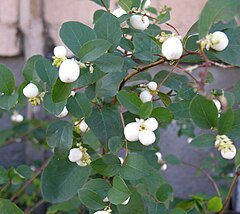Symphoricarpos albus
| Symphoricarpos albus subsp. var. | Common snowberry, Snowberry | |||||||||||||||||||||||||||||||||||||||||||||||||||||||
|---|---|---|---|---|---|---|---|---|---|---|---|---|---|---|---|---|---|---|---|---|---|---|---|---|---|---|---|---|---|---|---|---|---|---|---|---|---|---|---|---|---|---|---|---|---|---|---|---|---|---|---|---|---|---|---|---|

|
|
| ||||||||||||||||||||||||||||||||||||||||||||||||||||||
| ||||||||||||||||||||||||||||||||||||||||||||||||||||||||
Describe plant here...
| Standard Cyclopedia of Horticulture |
|---|
|
Symphoricarpos albus, Blake (S. racemosus, Michx. Vaccinium album, Linn.). Snowberry. Waxberry. Shrub with upright slender branches, 1-3 ft. high: lvs. oval to elliptic-oblong, obtuse, pubescent beneath, on shoots often sinuately lobed, 1-2 in. long: fls. in terminal spikes or axillary clusters; corolla campanulate, pinkish, about 1/4 in. long: fr. globose or ovoid, snow-white, 1/4 – 1/2 in. long. June-Sept.; fr. Sept.-Oct. Nova Scotia to Alaska south to Pa., Idaho, and Calif. Var. laevigatus, Blake (S. racemosus var. laevigatus, Fern.). Taller, to 6 ft., with glabrous usually larger lvs. and larger clusters of frs. Que. to Wash., south to Va., often escaped. Var. ovatus, Rehd. (S. ovatus, Spaeth). A form of the preceding with broadly ovate, bluish green lvs. mostly about 2 in. long and 1 3/4 in. broad, rounded or nearly truncate at the base.—The snowberry generally cult. as S. racemosus is the var. laevigatus, while typical S. albus is sometimes grown as var. pauciflorus, but the true var. pauciflorus, Blake, is a low shrub with smaller lvs. with grayish white pubescence beneath and only 1-3 fls. at the end of the branchlets; it is found from Lake Superior to Alberta and south to Colo. and Ore., and is apparently not in cult. CH
|
Cultivation
Propagation
Pests and diseases
Varieties
Gallery
References
External links
- w:Symphoricarpos albus. Some of the material on this page may be from Wikipedia, under the Creative Commons license.
- Symphoricarpos albus QR Code (Size 50, 100, 200, 500)



